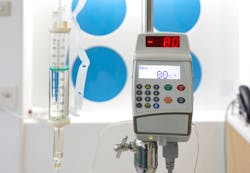How are senior leaders at hospitals nationwide leveraging data and information to help them manage medical devices? At a time in healthcare when every cost needs to be scrutinized and rationalized, leaders at Arkansas Children’s Hospital in Little Rock, Arkansas, have been saving $10,000 a month in cost savings on repairs and a 65-percent average cost savings per repair, per medical device. Faced with extended return times for – averaging 88 days – frequent recalls and price increases, the hospital turned to the Aurora, Ohio-based PartsSource, a healthcare services online marketplace and largest provider of medical replacement products, to obtain a platform that could provide data-driven decision support to simplify the procurement of medical device products and services from an evidence-based marketplace. With the recent addition of more than 1 million facilities products to support clinical engineering and facilities management healthcare teams, the hospital can purchase facilities products to manage costs, ensure quality and reduce staff time spent procuring equipment.
Recently, Healthcare Innovation Editor-in-Chief Mark Hagland spoke with Boyd Hutchins, the director of healthcare technology management at Arkansas Children’s Hospital, about his eight-engineer team’s strategy to optimize the management of the two-facility, 348-bed hospital’s 14,000 medical devices. Below are excerpts from that interview.
Tell me about the origins of the development of your strategy to optimally manage your organization’s medical devices?
This really started about three years ago. As a department, we decided that we needed to run things a little bit more efficiently, know what we had and where we had it, what we were spending. We were a high-functioning department We moved to Lean manufacturing principles and into an Agile framework, in our IS division. We started this journey back in 2007 in HIT, for maintaining medical equipment. We’re using what works from those kinds of methodologies.
We shifted in phases; first, we turned to one computerized medical management system, which represented a big change for us; and then we turned to PartsSource. As we began mapping our situation, we performed some time-and-motion studies as part of our Lean methodology, and found that our technicians were spending a lot of time on the phone shopping for the best prices for devices, and negotiating with vendors on prices, and it was bogging us down.
Those time studies showed we were wasting close to an FTE a week on the phone, placing phone calls. And if we had to call an original equipment manufacturer (OEM), that would have been even worse. So we connected with PartsSource; they’re kind of the Amazon for medical parts. There’s no website interface; we have access to their catalog.
And we’ve limited our choices to the OEM part; and they have quality metrics around their parts, including on-time delivery and part quality. So we allow for an OEM and a third party. So my technicians really don’t have to think about what they’re going to buy; they just click on the part, and purchase the order. They have the corporate credit cards uploaded. So that’s reduced drastically the amount of time we spend shopping for parts.
How big a team is shopping for parts?
It’s our entire team of technicians—eight people. That small size of our team speaks to the Lean and Agile methodologies we have in place.
What have you learned around process, in all this?
One thing we’ve learned lessons about, and something some of our old-school biomedical engineers struggle with, is the idea that if they call a local vendor with whom they have a relationship, they might get something cheaper. But what we’re learning is that if we leverage volume, even if we can’t find a one-off supplier that says, I can sell you this widget for a little less, we funnel all of our purchases through PartsSource. And over the course of the year, we’re actually saving money even if we pay a little bit more for individual parts. Their program is so efficient and cost-effective; I refuse to pay my technicians to fix infusion pumps. If it takes more than an hour to fix an infusion pump, we can save money over that. So we’re saving money and providing higher quality, because now we’re ensuring quality. That’s hard for some of my technicians to take, because they want to fix things, but most of them buy into it.
You report up to your CIO, correct?
Yes, I report to the VP of IT Infrastructure, who reports to the CIO.
Tell me about how your process speaks to issues around systematization and rationalization, in the important area of medical device management?
There’s a big push in the IS industry for something like the agile framework, where you have a standard process for working through projects; that dovetails with the Lean methodology, which focuses on standardizing work. And we have a standard way to work. At one point in our history, we had eight technicians placing orders from different vendors for infusion pump batteries. It was not organized. That was non-standard work, and we really didn’t know what we had on the shelf as far as replacement parts. So PartsSource really helped us to organize this, and instead of making onesie-twosie orders, we know how many infusion pump batteries we’ll need at any time, and according to PartsSource, we have one of the lowest overnight-delivery orders, because we have the batteries in stock and are ready for the next batch of patients arriving; we’re not scrambling to replace batteries. Just yesterday, we placed another quarterly order. So you can be Lean and Agile; and Agile is a philosophy; and that’s what we’ve adopted here.
How would you describe the evolution of this set of processes over time?
It’s evolved, and we’re working with our PartsSource account reps in terms of on-source biomedical equipment services. Let’s say half my shop has to quarantine because of COVID. We’re working with PartsSource to prepare orders in advance, so they’re working with us on developing that as well; the same with x-ray equipment. One of the things that we’re working on is the ability to trigger those services; and we can order services on the website, just as with a product. If our KPIs show we have too many work orders over a 30-day period, and if all those things turn red on our dashboard, we can arrange to have a biomedical engineer from PartsSource, onsite. And having that covered under our PartsSource agreement, just as we would any other service contract or medical device, we’re just paying a fee for service. I don’t have to open up a temporary employment contract or anything.
Is there anything that you’d like to add?
I have a specific example for you: we have an infusion pump; and recently, we had a new employee who didn’t remember what he was supposed to do, so he sent an infusion pump to the original manufacturer, and there was a 182-day turnaround time. When something gets over 30 days, I get involved and start calling the vendor. The OEM could not tell us where our pump was or estimate when it would come back; and then they divulged to me that they were using a third-party service. So I asked them, if you’re going to use a third-party service yourselves, and can’t tell me where my pump is, why wouldn’t I use my own third-party service? Once we had gotten that pump back, broken, because I demanded it back, PartsSource had it back to me, fixed, in seven days. And 99.6 percent of my infusion devices—pumps, syringe pumps, internal feeding pumps—are at our hospital and in safe working order right now. We have a KPI surrounding that as well, so that if it drops below 99 percent, that’s when we look at what we’re doing. We’re simply boxing things up and sending them to PartsSource, because they come back so quickly.


